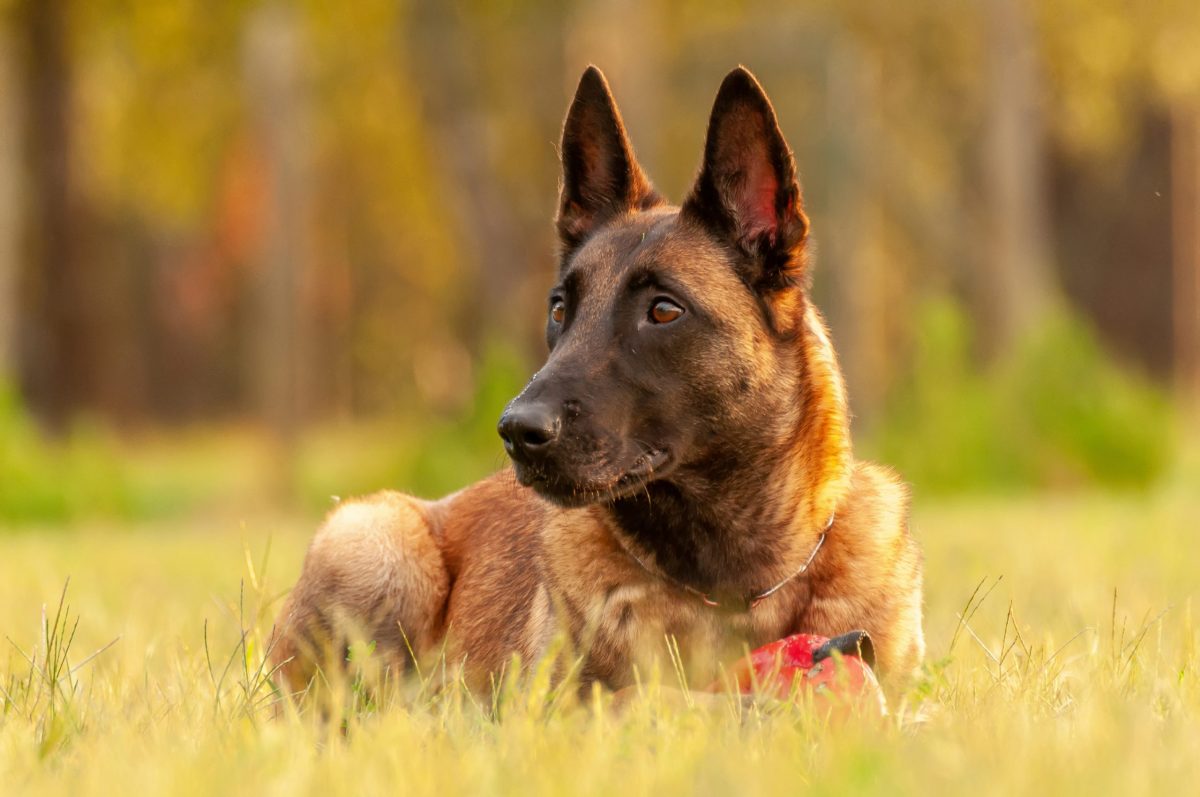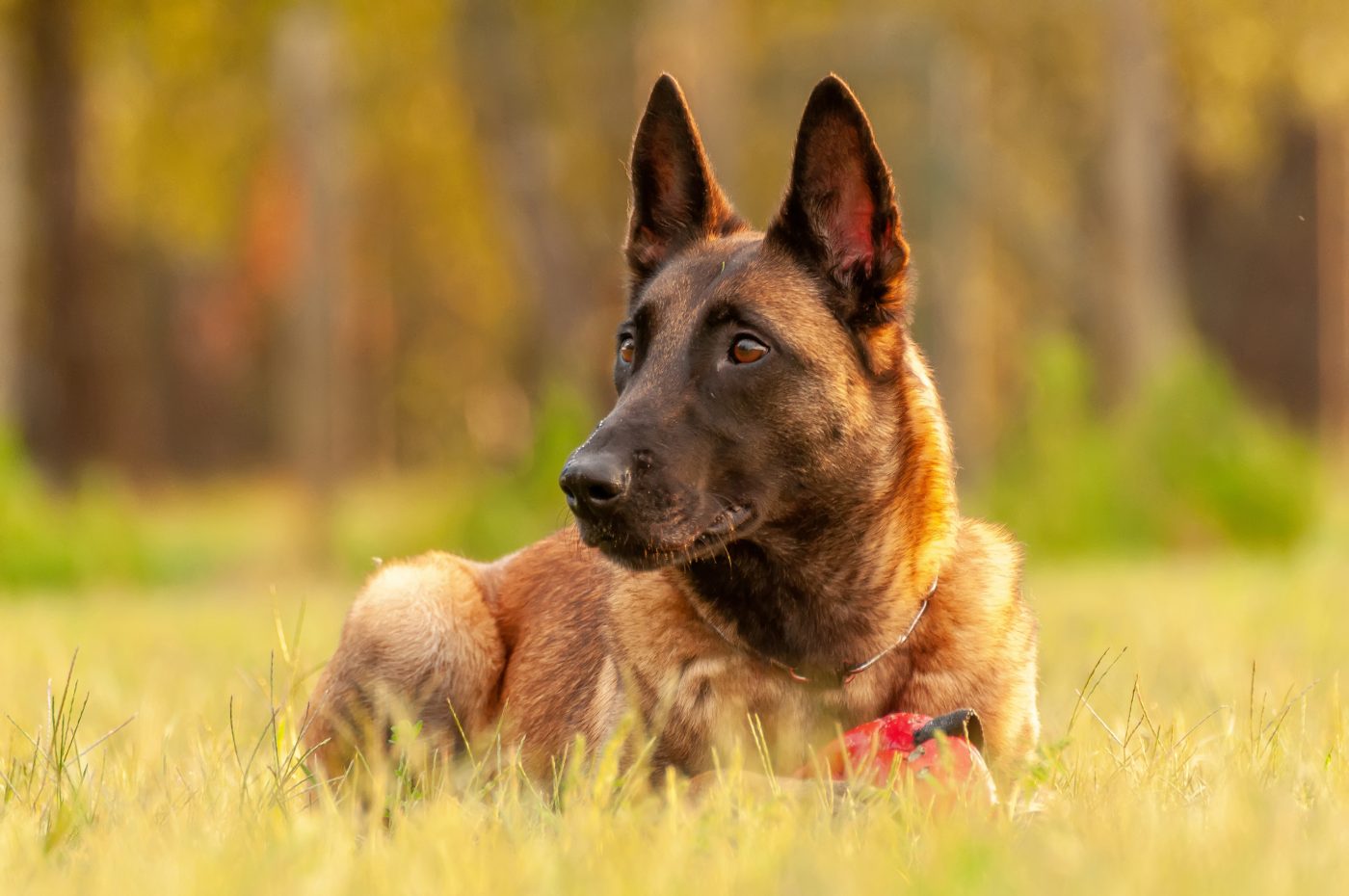
The Belgian Malinois, a breed renowned for its intelligence and athleticism, typically weighs between 40 to 80 pounds (18 to 36 kilograms) and stands 22 to 26 inches (56 to 66 centimeters) tall at the shoulder. These agile canines boast a lean, muscular build, tailored for agility and endurance. Their weight and height can vary based on factors such as gender, genetics, and individual health. Known for their versatility in various roles from police and military work to loyal family companionship, Belgian Malinois exemplify a blend of strength, grace, and unwavering loyalty in a strikingly elegant package.

Male Belgian Malinois Weights & Heights by Age
The following chart contains the average weights and heights of male Belgian Malinois from newborn to 3 years of age. Please note these are only averages. Always consult with your veterinarian if you have any concerns about your Belgian Malinois’ growth.
| Age (months) | Weight (lbs) | Weight (kg) | Height (in) | Height (cm) |
|---|---|---|---|---|
| 0 | 3-9 | 1.4-4.1 | 8-10 | 20-25 |
| 1 | 10-20 | 4.5-9.1 | 10-14 | 25-35 |
| 2 | 20-30 | 9.1-13.6 | 14-18 | 35-45 |
| 3 | 25-35 | 11.3-15.9 | 18-21 | 45-53 |
| 4 | 30-40 | 13.6-18.1 | 19-22 | 48-56 |
| 5 | 35-45 | 15.9-20.4 | 20-23 | 51-58 |
| 6 | 40-50 | 18.1-22.7 | 21-24 | 53-61 |
| 7 | 45-55 | 20.4-25 | 22-25 | 56-63 |
| 8 | 50-60 | 22.7-27.2 | 23-26 | 58-66 |
| 9 | 55-65 | 25-29.5 | 24-27 | 61-69 |
| 10 | 60-70 | 27.2-31.8 | 24-27 | 61-69 |
| 11 | 65-75 | 29.5-34 | 25-28 | 63-71 |
| 12 | 70-80 | 31.8-36.3 | 25-28 | 63-71 |
| 24 | 65-75 | 29.5-34 | 25-28 | 63-71 |
| 36 | 70-80 | 31.8-36.3 | 25-28 | 63-71 |
Female Belgian Malinois Weights & Heights by Age
The following chart contains the average weights and heights of female Belgian Malinois from newborn to 3 years of age. Please note these are only averages. Always consult with your veterinarian if you have any concerns about your Belgian Malinois’ growth.
| Age (months) | Weight (lbs) | Weight (kg) | Height (in) | Height (cm) |
|---|---|---|---|---|
| 0 | 3-9 | 1.4-4.1 | 8-10 | 20-25 |
| 1 | 10-20 | 4.5-9.1 | 10-14 | 25-35 |
| 2 | 20-30 | 9.1-13.6 | 14-18 | 35-45 |
| 3 | 25-35 | 11.3-15.9 | 18-21 | 45-53 |
| 4 | 30-40 | 13.6-18.1 | 19-22 | 48-56 |
| 5 | 35-45 | 15.9-20.4 | 20-23 | 51-58 |
| 6 | 40-50 | 18.1-22.7 | 21-24 | 53-61 |
| 7 | 45-55 | 20.4-25 | 22-25 | 56-63 |
| 8 | 50-60 | 22.7-27.2 | 23-26 | 58-66 |
| 9 | 55-65 | 25-29.5 | 24-27 | 61-69 |
| 10 | 60-70 | 27.2-31.8 | 24-27 | 61-69 |
| 11 | 65-75 | 29.5-34 | 25-28 | 63-71 |
| 12 | 70-80 | 31.8-36.3 | 25-28 | 63-71 |
| 24 | 65-75 | 29.5-34 | 25-28 | 63-71 |
| 36 | 70-80 | 31.8-36.3 | 25-28 | 63-71 |
These tables are based on general guidelines and can vary greatly depending on individual dogs. Always consult with a veterinarian or professional breeder for more specific information about your pet’s growth and development.
FAQs about a Belgian Malinois Puppy’s Growth and Development
1. How fast should my Belgian Malinois puppy grow?
Belgian Malinois puppies typically experience rapid growth in their first year, gaining weight and height quickly. By the age of 12 months, they usually reach close to their adult size, although some growth may continue up to 18 months.
2. How can I ensure my Belgian Malinois puppy is growing properly?
Regular visits to the veterinarian are crucial to monitor your puppy’s growth and overall health. Providing a balanced diet appropriate for their age and size, along with regular exercise, helps promote healthy growth and development.
3. When do Belgian Malinois puppies stop growing?
Most Belgian Malinois puppies reach their full height by around 12 months of age, but they may continue to fill out and gain muscle mass until they are around 18 to 24 months old.
4. Is my Belgian Malinois puppy’s growth rate normal?
Each Belgian Malinois puppy is unique, but generally, a healthy growth rate involves steady, consistent increases in weight and height over time. Sudden spurts or drastic changes in growth should be discussed with your veterinarian to ensure there are no underlying health concerns.
5. How much should I feed my Belgian Malinois puppy to support healthy growth?
Feeding guidelines vary based on factors such as age, weight, and activity level. It’s essential to follow the recommendations on the puppy food packaging and adjust portions as needed to maintain a healthy body condition score.
6. Should I be concerned if my Belgian Malinois puppy is not gaining weight?
If your puppy is not gaining weight as expected, it’s essential to consult with your veterinarian to rule out any underlying health issues. Poor weight gain could be due to inadequate nutrition, parasites, or other medical conditions that require attention.
7. Are there any signs of growth-related problems I should watch for in my Belgian Malinois puppy?
Signs of growth-related problems in Belgian Malinois puppies may include limping, difficulty walking or standing, reluctance to move, or abnormal bone or joint development. If you notice any of these signs, consult with your veterinarian promptly.
8. Can overfeeding affect my Belgian Malinois puppy’s growth?
Overfeeding can lead to excessive weight gain, which may put strain on your puppy’s developing bones and joints. It’s essential to feed your puppy an appropriate amount of food to prevent obesity and promote healthy growth.
9. How often should I exercise my Belgian Malinois puppy to support growth and development?
Regular, moderate exercise is essential for promoting healthy growth and development in Belgian Malinois puppies. Aim for several short play sessions throughout the day, gradually increasing the duration and intensity as your puppy grows older.
10. Should I restrict my Belgian Malinois puppy’s physical activity to prevent injury during growth?
While it’s essential to avoid overexertion and high-impact activities that could strain your puppy’s developing joints, moderate exercise is still important for overall health and development. Encourage controlled, low-impact activities such as walking, swimming, and interactive play.
11. Are there specific nutritional requirements for my Belgian Malinois puppy during growth?
Belgian Malinois puppies require a balanced diet rich in protein, vitamins, and minerals to support their rapid growth and development. Choose a high-quality puppy food formulated to meet the nutritional needs of large-breed puppies.
12. When should I transition my Belgian Malinois puppy from puppy food to adult food?
Most Belgian Malinois puppies can transition to adult food between 12 to 18 months of age, once they have reached their full height and their growth rate has slowed. Gradually introduce the new food over a period of several days to minimize digestive upset.
13. How can I ensure my Belgian Malinois puppy’s bones and joints develop properly?
Providing a balanced diet, regular exercise, and maintaining a healthy weight are crucial for supporting proper bone and joint development in Belgian Malinois puppies. Avoid excessive jumping or activities that put stress on growing bones and joints.
14. Can genetics affect my Belgian Malinois puppy’s growth and development?
Genetics play a significant role in determining your puppy’s growth rate, size, and overall development. Understanding your puppy’s pedigree and any potential health concerns within their lineage can help you anticipate and address any growth-related issues.
15. What vaccinations does my Belgian Malinois puppy need during growth?
Your veterinarian will create a customized vaccination schedule for your Belgian Malinois puppy based on factors such as age, lifestyle, and geographic location. Core vaccinations, such as those for distemper, parvovirus, and rabies, are typically recommended to protect against common infectious diseases.
16. How can I help my Belgian Malinois puppy adjust to their changing size and weight?
As your Belgian Malinois puppy grows, provide them with a comfortable, safe environment where they can navigate their changing body with confidence. Use positive reinforcement techniques to encourage good behavior and discourage any rough play that could lead to injuries.
17. Are there any supplements that can support my Belgian Malinois puppy’s growth and development?
Consult with your veterinarian before adding any supplements to your puppy’s diet, as excessive or inappropriate supplementation can have adverse effects. In some cases, supplements such as glucosamine and chondroitin may be recommended to support joint health, especially in large-breed puppies prone to orthopedic issues.
18. How often should I schedule veterinary check-ups for my Belgian Malinois puppy during growth?
Regular veterinary check-ups are essential for monitoring your puppy’s growth, development, and overall health. Your veterinarian will create a customized wellness plan, which may include routine examinations, vaccinations, and preventive care measures.
19. Can neutering or spaying affect my Belgian Malinois puppy’s growth?
Neutering or spaying can affect hormone levels, which may influence your puppy’s growth rate and development. It’s essential to discuss the timing of these procedures with your veterinarian to ensure they are performed at an appropriate age and stage of growth.
20. What should I do if I have concerns about my Belgian Malinois puppy’s growth?
If you have any concerns about your Belgian Malinois puppy’s growth or development, don’t hesitate to contact your veterinarian. They can provide guidance, perform a thorough examination, and address any underlying issues to help ensure your puppy grows up happy, healthy, and thriving.
Discover more from reviewer4you.com
Subscribe to get the latest posts to your email.





